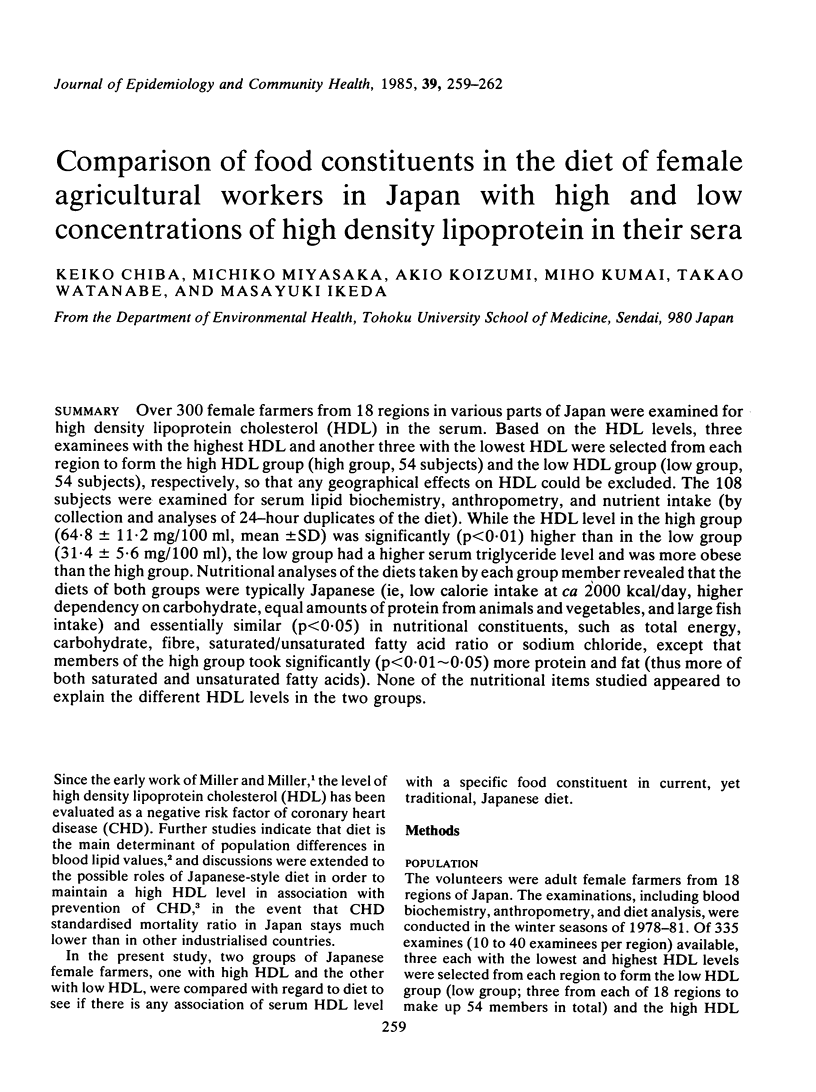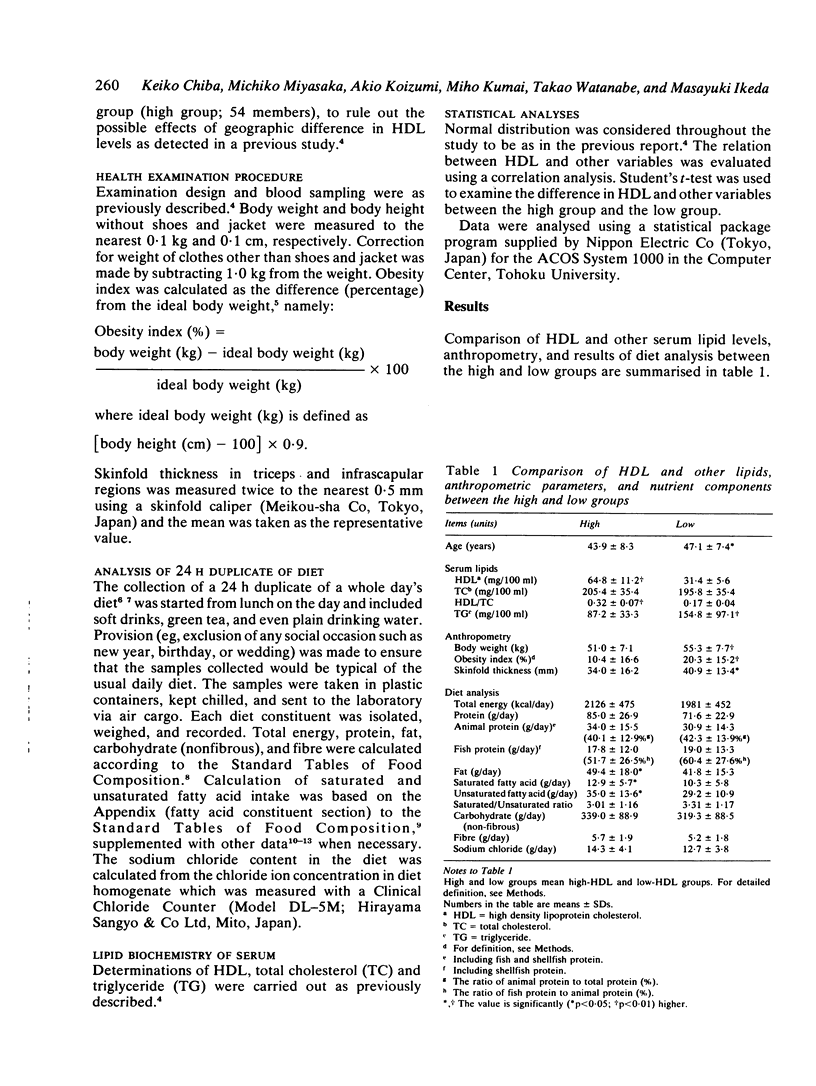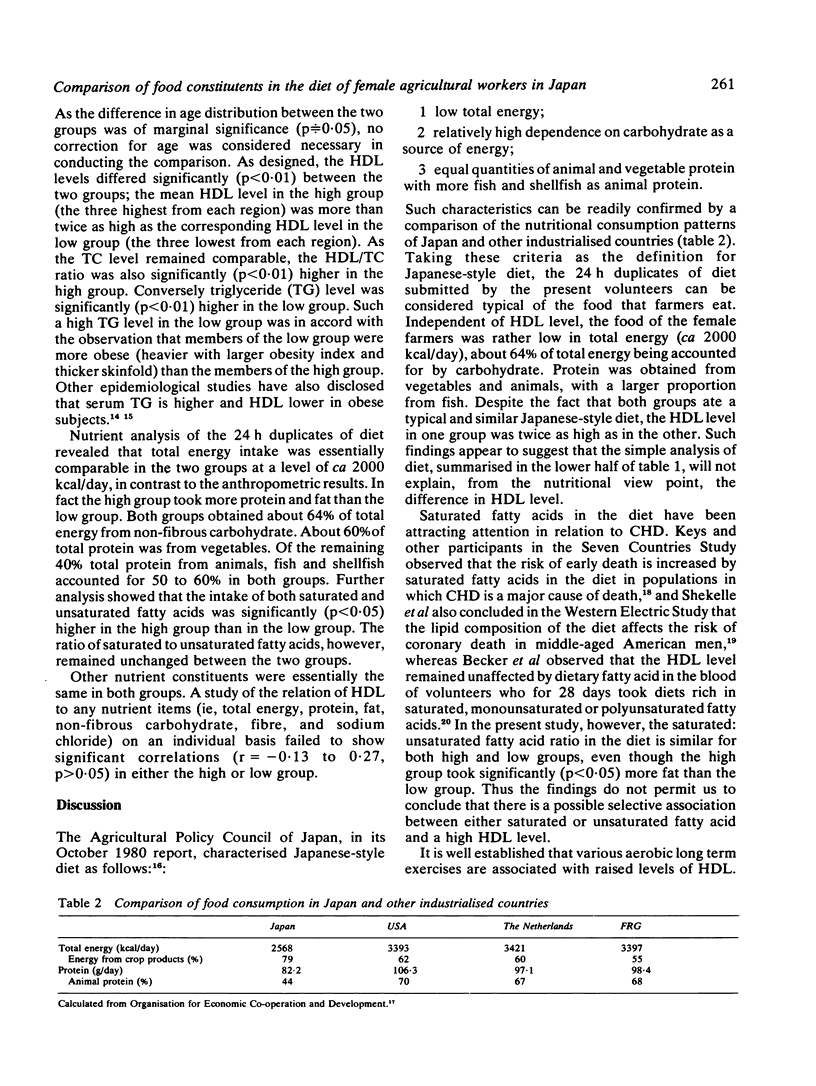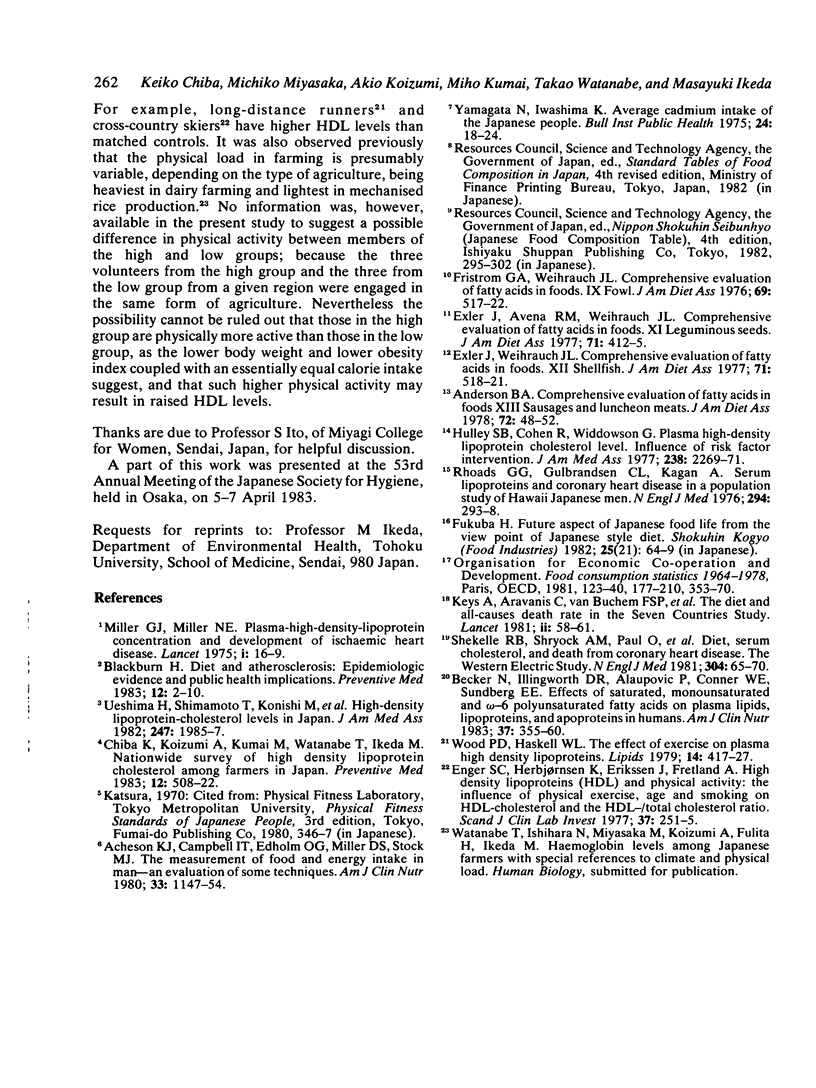Abstract
Over 300 female farmers from 18 regions in various parts of Japan were examined for high density lipoprotein cholesterol (HDL) in the serum. Based on the HDL levels, three examinees with the highest HDL and another three with the lowest HDL were selected from each region to form the high HDL group (high group, 54 subjects) and the low HDL group (low group, 54 subjects), respectively, so that any geographical effects on HDL could be excluded. The 108 subjects were examined for serum lipid biochemistry, anthropometry, and nutrient intake (by collection and analyses of 24-hour duplicates of the diet). While the HDL level in the high group (64.8 +/- 11.2 mg/100 ml, mean +/- SD) was significantly (p less than 0.01) higher than in the low group (31.4 +/- 5.6 mg/100 ml), the low group had a higher serum triglyceride level and was more obese than the high group. Nutritional analyses of the diets taken by each group member revealed that the diets of both groups were typically Japanese (ie, low calorie intake at ca 2000 kcal/day, higher dependency on carbohydrate, equal amounts of protein from animals and vegetables, and large fish intake) and essentially similar (p less than 0.05) in nutritional constituents, such as total energy, carbohydrate, fibre, saturated/unsaturated fatty acid ratio or sodium chloride, except that members of the high group took significantly (p less than 0.01 approximately 0.05) more protein and fat (thus more of both saturated and unsaturated fatty acids). None of the nutritional items studied appeared to explain the different HDL levels in the two groups.
Full text
PDF



Selected References
These references are in PubMed. This may not be the complete list of references from this article.
- Acheson K. J., Campbell I. T., Edholm O. G., Miller D. S., Stock M. J. The measurement of food and energy intake in man-an evaluation of some techniques. Am J Clin Nutr. 1980 May;33(5):1147–1154. doi: 10.1093/ajcn/33.5.1147. [DOI] [PubMed] [Google Scholar]
- Anderson B. A. XIII. Sausages and luncheon meats. Comprehensive evaluation of fatty acids in foods. J Am Diet Assoc. 1978 Jan;72(1):48–52. [PubMed] [Google Scholar]
- Becker N., Illingworth D. R., Alaupovic P., Connor W. E., Sundberg E. E. Effects of saturated, monounsaturated, and omega-6 polyunsaturated fatty acids on plasma lipids, lipoproteins, and apoproteins in humans. Am J Clin Nutr. 1983 Mar;37(3):355–360. doi: 10.1093/ajcn/37.3.355. [DOI] [PubMed] [Google Scholar]
- Blackburn H. Diet and atherosclerosis: epidemiologic evidence and public health implications. Prev Med. 1983 Jan;12(1):2–10. doi: 10.1016/0091-7435(83)90161-5. [DOI] [PubMed] [Google Scholar]
- Chiba K., Koizumi A., Kumai M., Watanabe T., Ikeda M. Nationwide survey of high-density lipoprotein cholesterol among farmers in Japan. Prev Med. 1983 Jul;12(4):508–522. doi: 10.1016/0091-7435(83)90205-0. [DOI] [PubMed] [Google Scholar]
- Enger S. C., Herbjørnsen K., Erikssen J., Fretland A. High density lipoproteins (HDL) and physical activity: the influence of physical exercise, age and smoking on HDL-cholesterol and the HDL-/total cholesterol ratio. Scand J Clin Lab Invest. 1977 May;37(3):251–255. doi: 10.3109/00365517709091490. [DOI] [PubMed] [Google Scholar]
- Exler J., Avena R. M., Weihrauch J. L. XI. Leguminous seeds. Comprehensive evaluation of fatty acids in foods. J Am Diet Assoc. 1977 Oct;71(4):412–415. [PubMed] [Google Scholar]
- Exler J., Weihrauch J. L. Comprehensive evaluation of fatty acids in foods. J Am Diet Assoc. 1977 Nov;71(5):518–521. [PubMed] [Google Scholar]
- Fristrom G. A., Weihrauch J. L. Comprehensive evaluation of fatty acids in foods. IX. Fowl. J Am Diet Assoc. 1976 Nov;69(5):517–522. [PubMed] [Google Scholar]
- Hulley S. B., Cohen R., Widdowson G. Plasma high-density lipoprotein cholesterol level. Influence of risk factor intervention. JAMA. 1977 Nov 21;238(21):2269–2271. [PubMed] [Google Scholar]
- Miller G. J., Miller N. E. Plasma-high-density-lipoprotein concentration and development of ischaemic heart-disease. Lancet. 1975 Jan 4;1(7897):16–19. doi: 10.1016/s0140-6736(75)92376-4. [DOI] [PubMed] [Google Scholar]
- Okafor C. O., Steenberg M. L., Buckley J. P. Studies in the heterocyclic series. XVI. Open azaphenothiazines as new central nervous system depressants. Chem Pharm Bull (Tokyo) 1982 Jan;30(1):302–318. doi: 10.1248/cpb.30.302. [DOI] [PubMed] [Google Scholar]
- Rhoads G. G., Gulbrandsen C. L., Kagan A. Serum lipoproteins and coronary heart disease in a population study of Hawaii Japanese men. N Engl J Med. 1976 Feb 5;294(6):293–298. doi: 10.1056/NEJM197602052940601. [DOI] [PubMed] [Google Scholar]
- Shekelle R. B., Shryock A. M., Paul O., Lepper M., Stamler J., Liu S., Raynor W. J., Jr Diet, serum cholesterol, and death from coronary heart disease. The Western Electric study. N Engl J Med. 1981 Jan 8;304(2):65–70. doi: 10.1056/NEJM198101083040201. [DOI] [PubMed] [Google Scholar]
- The diet and all-causes death rate in the Seven Countries Study. Lancet. 1981 Jul 11;2(8237):58–61. [PubMed] [Google Scholar]
- Ueshima H., Iida M., Shimamoto T., Konishi M., Tanigaki M., Nakanishi N., Takayama Y., Ozawa H., Kojima S., Komachi Y. High-density lipoprotein-cholesterol levels in Japan. JAMA. 1982 Apr 9;247(14):1985–1987. [PubMed] [Google Scholar]
- Wood P. D., Haskell W. L. The effect of exercise on plasma high density lipoproteins. Lipids. 1979 Apr;14(4):417–427. doi: 10.1007/BF02533428. [DOI] [PubMed] [Google Scholar]


